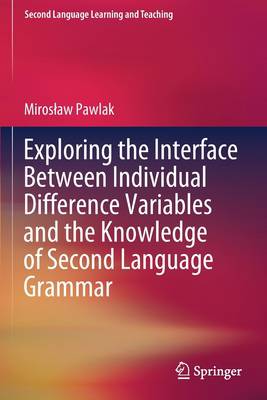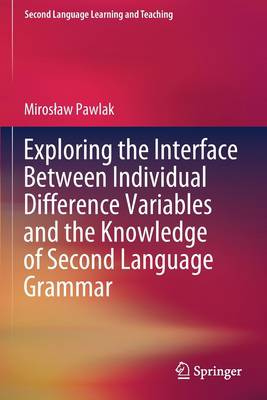
Door een staking bij bpost kan je online bestelling op dit moment iets langer onderweg zijn dan voorzien. Dringend iets nodig? Onze winkels ontvangen jou met open armen!
- Afhalen na 1 uur in een winkel met voorraad
- Gratis thuislevering in België vanaf € 30
- Ruim aanbod met 7 miljoen producten
Door een staking bij bpost kan je online bestelling op dit moment iets langer onderweg zijn dan voorzien. Dringend iets nodig? Onze winkels ontvangen jou met open armen!
- Afhalen na 1 uur in een winkel met voorraad
- Gratis thuislevering in België vanaf € 30
- Ruim aanbod met 7 miljoen producten
Zoeken
Exploring the Interface Between Individual Difference Variables and the Knowledge of Second Language Grammar
Miroslaw Pawlak
€ 105,45
+ 210 punten
Uitvoering
Omschrijving
The last few decades have seen extensive research focusing of the relative effectiveness of different instructional options that can be employed in teaching grammar structures (e.g., deduction and induction, different types of corrective feedback, input-based vs. output-based practice). However, the contribution of such pedagogical intervention and the resulting knowledge of target language grammar are mediated by a number of factors related to a specific context, the properties of the features being taught and, most importantly, individual learner profiles. Nonetheless, research into the moderating role of individual difference variables has been scant, limited to only several factors, and seldom taking into account complex interactions between variables. The book seeks to fill this evident gap by investigating the mediating effect of selected cognitive and affective factors on explicit and implicit (or highly automatized) knowledge of the English passive voice. In doing so, the study sheds the so-much-needed light on the predictors of second language grammar knowledge but also, to some extent, on the usefulness of instructional techniques used to develop it.
Specificaties
Betrokkenen
- Auteur(s):
- Uitgeverij:
Inhoud
- Aantal bladzijden:
- 137
- Taal:
- Engels
- Reeks:
Eigenschappen
- Productcode (EAN):
- 9783030848811
- Verschijningsdatum:
- 26/08/2022
- Uitvoering:
- Paperback
- Formaat:
- Trade paperback (VS)
- Afmetingen:
- 156 mm x 234 mm
- Gewicht:
- 217 g

Alleen bij Standaard Boekhandel
+ 210 punten op je klantenkaart van Standaard Boekhandel
Beoordelingen
We publiceren alleen reviews die voldoen aan de voorwaarden voor reviews. Bekijk onze voorwaarden voor reviews.











